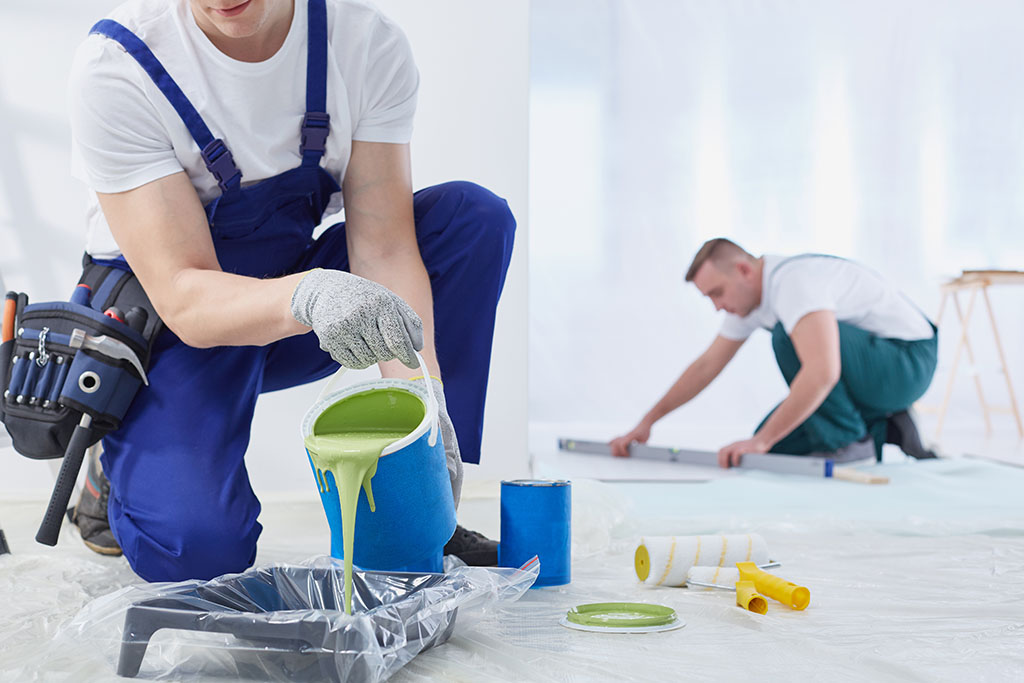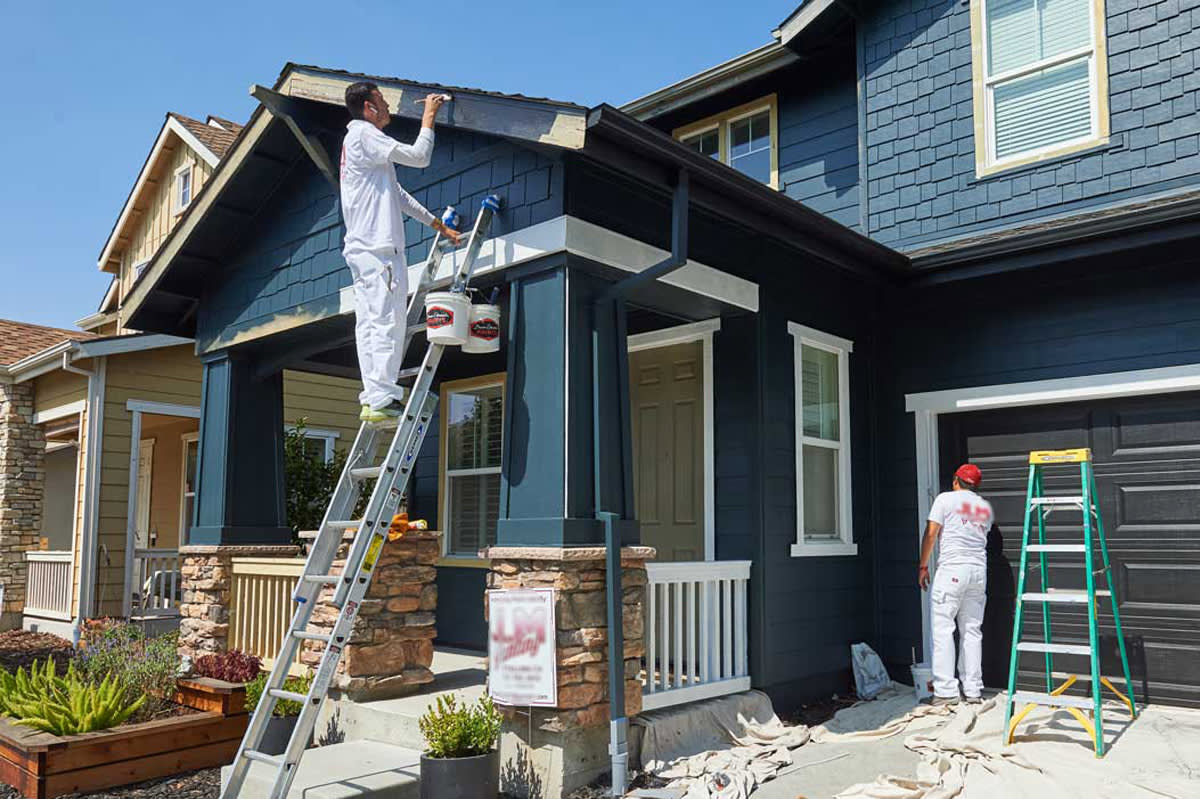Discover the most recent Fads in Paint Blends for Your Home Remodeling

Exploring Shade Concept: The Basics of Paint Blends
Shade theory functions as the foundation for comprehending paint assimilate home remodelings. It includes the study of how colors communicate and influence one another, playing a considerable function in developing harmonious spaces. At its core, color theory includes main, additional, and tertiary shades, which can be integrated to create numerous tones and tones. Recognizing color relationships, such as corresponding, similar, and triadic, helps homeowners select combinations that stimulate preferred feelings and environments.
Additionally, the principles of warm and cool colors direct options that influence the assumption of space. Warm colors, like reds and yellows, can create comfort, while great colors, such as blues and greens, advertise peace. By grasping these concepts, people can make informed decisions about paint blends, guaranteeing that their home remodeling reflects their individual design while accomplishing a balanced aesthetic conducive to their living atmosphere.
Trending Color Mixes for 2023
As homeowners seek to freshen their spaces, trending color combinations for 2023 offer a vibrant combination that resonates with contemporary looks. This year, natural tones such as terracotta and olive environment-friendly are obtaining popularity, offering a warm, inviting ambience. Paired with soft neutrals like off-white and cream, these colors produce an unified balance that improves both modern-day and traditional insides.
Furthermore, strong contrasts are on the increase, with deep navy blue and mustard yellow making a striking statement. This mix includes depth and energy to any space. Pastel tones, consisting of soft lavender and mint green, continue to beauty, promoting a soothing and tranquil setting.
Last but not least, single plans featuring differing shades of a solitary color, such as rich emerald green, are appealing for their refinement and simplicity. These trending mixes reflect a desire for spaces that really feel both customized and elegant, aligning perfectly with existing layout choices.
Techniques for Mixing Paint Like a Pro
Blending paint flawlessly calls for skill and technique, transforming average wall surfaces right into sensational masterpieces. Professional painters typically make use of numerous methods to achieve remarkable outcomes. One preferred method is the "feathering" method, where a dry brush is used to soften the sides in between various shades. This produces a smooth shift and removes severe lines.
Another effective method is the "ombre" method, which involves slowly mixing two or even more shades from light to dark. This needs careful layering and constant brush strokes to maintain a seamless circulation.
Utilizing a sponge or rag can also enhance mixing, permitting one-of-a-kind appearances and subtle color variations. It is important to function in small areas, blending shades while they are still here are the findings wet to ascertain a natural look. Proficiency of these methods can elevate any kind of paint job, offering deepness and elegance to a home's ambiance.
Including Appearance and Patterns in Paint Blends
Incorporating texture and patterns into paint blends can boost the aesthetic appeal of any kind of room, adding deepness and personality. Designers increasingly utilize techniques such as sponging, rag rolling, and stenciling to create special results that attract the eye. These approaches enable the layering of textures and shades, boosting the general design.
Using textured paint items can also introduce measurement to wall surfaces, making them extra dynamic. As an example, a matte finish can contrast magnificently with a glossy pattern, creating a striking visual interplay.
Patterns, whether geometric or natural, can be seamlessly integrated into blends, enabling individualized aesthetic expressions (corpus christi tx paint shop). Prints can be utilized sparingly as accents or more thoroughly for a bold declaration
Ultimately, the thoughtful unification of structure and patterns in paint blends changes average areas into enchanting atmospheres, reflecting individual design while maintaining a natural appearance throughout the home.
Room-by-Room Overview to Paint Blends
The application of paint blends can differ significantly from one space to one more, each space offering one-of-a-kind possibilities for creative thinking and personalization (paint shops in corpus christi). In living spaces, warm hues can create a welcoming environment, while cooler tones may advertise relaxation. A mix of soft eco-friendlies and blues can breathe life into a kitchen, making it really feel fresh and lively

Hallways and entranceways benefit from corresponding blends that guide the eye with the home, often using lighter tones to develop a sense of openness. In children's rooms, playful mixes of brilliant shades urge imagination and fun, enabling a space that expands with the child. Each room's character can be beautifully expressed through thoughtful paint blends.
Tips for Picking the Right Sheen and finish
Exactly how does one figure out the best surface and luster for their paint task? The option of finish substantially affects the general appearance and longevity of a painted surface area. Normally, coatings range from level to high-gloss, each serving different visual and useful objectives. For high-traffic locations, such as cooking areas and hallways, a satin or semi-gloss coating is a good idea, as these are simpler to cleanse and stand up to moisture. On the other hand, flat coatings function well in low-traffic spaces, supplying a subtle, non-reflective appearance.
In addition, light can influence shine assumption; a room with sufficient natural light may gain from a matte surface to soften brightness. It is additionally vital to consider the space's purpose; as an example, a comfortable space could ask for a warm eggshell finish. Eventually, understanding the balance in between visual appeals and functionality can assist people in choosing the suitable surface and shine for their home's makeover.
Often Asked Questions

Can I Mix Paint Colors Myself, or Should I Hire an Expert?
Blending paint shades can be done independently, allowing for individual creative thinking. Hiring an expert might guarantee a lot more specific results and proficiency, specifically for intricate layouts or attaining a details visual vision in home decoration.
Exactly how Do I Keep Mixed Paint Finishes In Time?
To preserve blended paint finishes, routine cleansing with light soap and water is essential. Stay clear of rough cleansers, and repair any kind of scrapes or scuffs without delay. Correct ventilation can also assist protect the paint's vibrancy gradually.
Are There Eco-Friendly Paint Options for Mixing?
Yes, there are environmentally friendly paint options for blending, consisting of all-natural and low-voc paints. These items lessen unsafe discharges and use lasting materials, allowing people to attain stunning surfaces while prioritizing ecological health and wellness.
What Tools Do I Need for Mixing Paint Properly?
To blend paint properly, one requires high-quality brushes, rollers, a paint tray, painter's tape, a combination blade, and a spray container for misting. These tools ensure smooth shifts and professional-looking cause any click for more info type of painting task.
Just how Do I Fix Blunders in My Paint Blends?
To take care of mistakes in paint blends, one can gently sand the area, apply a primer, and paint utilizing the correct technique. corpus christi paint store. Persistence and practice are vital for achieving smooth, professional-looking lead to paint blending
Color theory offers as the structure for understanding paint blends in home makeovers. The application of paint blends can differ significantly from one space to another, each room offering special opportunities for creative thinking and personalization. Mixing paint colors can be done separately, allowing for individual creative thinking. Yes, there are environmentally friendly paint alternatives for blending, consisting of low-VOC and natural paints. To blend paint properly, one needs high-grade brushes, rollers, a paint tray, painter's tape, a combination knife, and a spray bottle for misting.